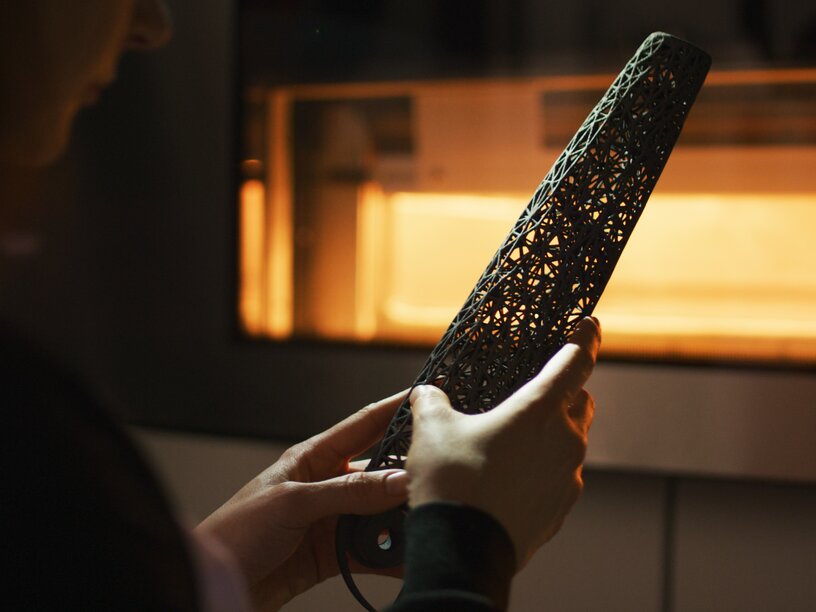
The Right Input
Our Polymers for 3D Printing
Plastic Materials for Additive Manufacturing
EOS Plastic Materials - Vast Selection for Remarkable Part Properties
At EOS, we have exceptional materials expertise and a comprehensive portfolio of 3D printer plastic materials. These advanced plastic and polymer materials are perfectly suited for selective laser sintering in additive manufacturing. Our 3D printing materials, systems, and process parameters are based on many years of experience and are optimally coordinated. This offers many advantages: With the right EOS materials, you can realize the desired property profiles of your 3D print in the best possible way. EOS is also continuously developing its range of high-tech materials for special customer requirements.
We offer a comprehensive selection of materials for the production of plastic parts using additive manufacturing processes. This allows highly robust products to be manufactured in first-class quality. The following 3D printing plastic materials are available: Polyamides (PA), Thermoplastic Elastomers (TPE) and Polyaryletherketones (PAEK). Our PA 11 and PA 12 materials are also available in a carbon-reduced and carbon-neutral version.
Benefit from Our 3D Printing Plastic Materials Expertise
-
Perfectly matched 3D printing materials, systems and process parameters for optimal results.
-
Tried and tested build quality across a range of materials
-
Wide range of 3D printing materials for different property profiles and requirements such as strength, impact strength, temperature resistance, dimensional stability, or biocompatibility.
-
Cost-efficient production of innovative industry-standard components through efficient production processes and high-tech materials.
3D Printing Plastic Materials Meet Every Requirement
Biocompatible
Biocompatible plastics from EOS offer numerous advantages over metal and other materials when used for prosthetics and orthotics, medical equipment or medical device applications. The material properties include strength, malleability, longevity, optimized performance, and chemical inertness. They offer better corrosion resistance to disinfectants than metals.
Biocompatible 3D printing material options available at EOS are TPU, PA 11 and PA 12. Products made from these plastics can meet the requirements of highly regulated industries and can be CE-certified.

Ductile
The high-performance polyamide 11 (PA 11) is made from 100% renewable castor beans. This plastic material, also known as nylon, is chemically and mechanically heat-resistant and is ideally suited for highly technical applications thanks to its durability. EOS materials of this class are an efficient, impact-resistant alternative to the plastics ABS or PA6, which have proven their value in injection molding. The additively manufactured end products are just as strong, flexible, and durable as molded parts.

Flame Retardant
Flame retardant plastics from EOS are well suited for demanding applications that require heat resistance, or must be non-flammable and self-extinguishing.
Flame retardant 3D printing material options available at EOS are PA 11 and PA 12. Products made from these plastics can meet the requirements of highly regulated industries like aerospace, electrical and electronics equipment, as well as the mobility industry.

Flexible
Materials of the TPE polymer class have similar properties to elastomers – this means that they are flexible at room temperature but still remain dimensionally stable. When heated, they can be plastically deformed and processed like thermoplastics. Since they are easy to process, they can be used to replace cross-linked elastomers and soft PVC.

High Performance
Materials in this family of polymers are chemical compounds with ether and ketone groups. Compared to other plastics, they have very high glass transition and melting temperatures, which is why they are used in high-temperature applications.
PAEK materials are semi-crystalline aromatic polyetherketones with excellent mechanical properties even at high temperatures. They permit continuous operating temperatures of up to 260°C. They are flame-retardant and have high chemical resistance, hydrolysis resistance, high stiffness and strength, as well as very good tribological properties.

Multipurpose
Polyamide 12 (PA 12), also known as nylon, is the most tested material for additive manufacturing on the market. Parts made from nylon are robust, stable for long periods of time, chemically resistant, and extremely versatile. EOS materials based on polyamide 12 are a high-performance alternative to plastics like ABS or PA6 that have proven their value in injection molding. The additively manufactured end products are just as strong, flexible, and durable as injection molded parts.

Plastics are important materials in additive manufacturing. The composition of the polymers enables different material properties for a variety of applications. There are various 3D printing processes that differ both in the materials used and in the product properties achieved.
Fused Deposition Modeling (FDM), in which ABS or PLA filament is melted in the printer head and then extruded, is probably the most common variant of 3D printing and is used primarily in the consumer sector. Stereolithography (SLA) uses liquid resins that are cured with a laser.
Selective Laser Sintering (SLS), the technology perfected by EOS, uses plastic polymers in powder form that are fused using a precise laser. The result is robust functional parts with high design freedom, as no support structures are required.
Germany-centered Take-back Program for Used Polymer Materials & Parts
KaJo Plastic GmbH & Co. KG takes back even small quantities of used polymer material and 3D printed parts, transforming powder into recycled injection molding granules and more. KaJo Plastic GmbH & Co. KG serves customers in Germany and surrounding countries, e.g., Netherlands, Switzerland, Austria or France.



